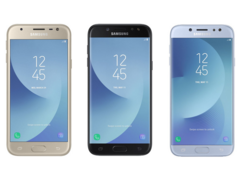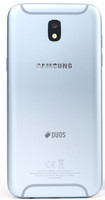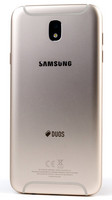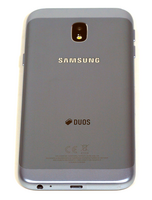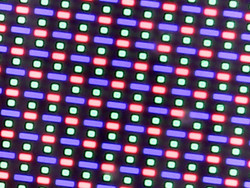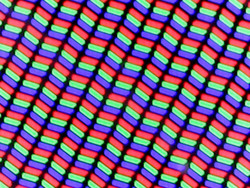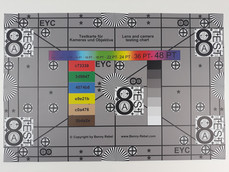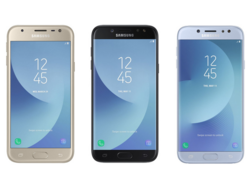For the original German article, see here.
This year also, Samsung is sticking with its Galaxy-J series, and with the Galaxy J3 (2017), the Galaxy J5 (2017), and the Galaxy J7 (2017) introduces its new entry-level smartphones. Even though all three models are considered part of the entry-level segment, there are important differences between the models of the J-series in terms of their specifications. We would like to take a closer look at the three smartphones and find out which device is best for which kind of user.
| Specifications | Galaxy J3 (2017) | Galaxy J5 (2017) | Galaxy J7 (2017) |
|---|---|---|---|
| Processor | Samsung Exynos 7570 Quad | Samsung Exynos 7870 Octa | Samsung Exynos 7870 Octa |
| Graphics card | ARM Mali-T720 MP2 | ARM Mali-T830 MP1 | ARM Mali-T830 MP1 |
| Storage | 2 GB RAM / 16 GB ROM | 2 GB RAM / 16 GB ROM | 3 GB RAM / 16 GB ROM |
| Display | 5 inch PLS | 5.2 inch Super-AMOLED | 5.5 inch Super-AMOLED |
| Resolution | 1280 x 720 | 1280 x 720 | 1920 x 1080 |
| Sensors | acceleration and proximity sensors | acceleration, geomagnetic, hall, proximity, G, and brightness sensors | acceleration, geomagnetic, hall, proximity, G, and brightness sensors |
| Battery | 2400 mAh | 3000 mAh | 3600 mAh |
Visually, the models of this year's update of Samsung's Galaxy-J series are not very different. As in the previous years, the manufacturer’s recommended price, the display diagonal and hence the case dimensions of the three models have increased. With a street price of 300 Euros ($357; starting at ~$220 in the US), the Samsung Galaxy J7 (2017) is not only the largest at 5.5 inches, but also the most expensive of the three models, followed by the Galaxy J5 (2017) at 5.2 inches (230 Euros, ~$274) and the Galaxy J3 (2017) with a display diagonal of 5 inches and a current price of about 170 Euros (~$202).
Size and Features
While the Samsung Galaxy J3 (2017) has a plastic case, the two other Galaxy J5 and J7 models have a metal case. All models are offered in black, gold, and bright metallic blue colors.
As our tests show, the quality of the cases is similarly good in all our test units. Despite its affordable price, the Galaxy J3 (2017) is also well-built and the gaps are even.
The differences in terms of the technical equipment in the Samsung Galaxy J3 (2017), J5 (2017), and J7 (2017) become quite clear in the communication modules. The WLAN module of the Galaxy-J smartphones supports the IEEE-802.11 standards according to a/b/g/n/ac and thus communicates in the 2.4 and 5 GHz band. An exception is the Galaxy J3 (2017), which only uses the IEEE-802.11 b/g/n standards - the absolute minimum. The measurements with our Linksys EA8500 reference router reflect the differences. While the transfer rates in the Galaxy J5 (2017) and Galaxy J7 (2017) are very good and similarly high, they are considerably lower in the Galaxy J3 (2017). There is a difference of about 80% between the entry-level device and the two mid-range models. All the models include an NFC chip.
| Networking | |
| iperf3 transmit AX12 | |
| Samsung Galaxy J5 (2017) Duos | |
| Samsung Galaxy J7 2017 | |
| Samsung Galaxy J3 2017 | |
| iperf3 receive AX12 | |
| Samsung Galaxy J5 (2017) Duos | |
| Samsung Galaxy J7 2017 | |
| Samsung Galaxy J3 2017 | |
Performance and Storage
The storage equipment of the Samsung Galaxy-J-2017 models is very similar. All three models have eMMC storage with a capacity of 16 GB. This is accompanied by 2 GB or in the case of Galaxy J7 (2017) top model by 3 GB of LPDDR3 working memory and the ability to expand the storage. With the SDXC standard, all the usual storage media are supported. Our measurements in the AndroBench results paint a picture of relatively evenly distributed access rates. The speeds range on a similar level so that the differences between the models should hardly be noticeable. With the exception of the value for sequential reads in the Galaxy J5 (2017), the speeds of the microSD card slot are also very similar.
In terms of the performance level, there is a greater gap between the two Galaxy J5 (2017) and Galaxy J7 (2017) mid-range models and the Galaxy J3 (2017) entry-level model. The latter is equipped with an Exynos-7570 SoC, which offers only 4 instead of 8 cores and much less performance compared to the Exynos 7870 of the two higher priced models. The same goes for the integrated graphics unit. The graphics computations of the ARM Mali-T720 MP2 in the Galaxy J3 (2017) are considerably slower compared to the ARM Mali-T830 MP1 in the Galaxy J5 (2017) and Galaxy J7 (2017). In our benchmark test, the performance difference between the two Samsung SoCs was about 15 to 50%. A similar picture shows in the results of the browser benchmarks.
Things look completely different in the two more expensive J models. Even though with 3 GB of RAM, the Galaxy J7 (2017) has slightly more working memory than the Galaxy J5 (2017) since the 1080 panel the Exynos 7870 has to move around almost four times as many pixels than the J5 (2017) with its HD resolution. Therefore the more affordable of the two Galaxy-J models does even slightly better in the synthetic benchmarks.
In everyday life usage, all three J models show minor weaknesses. You can notice small delays when changing apps, and often the computing power is overwhelmed by the multi-Windows mode. The "Upday for Samsung" in particular, an app for personalized news and notices, slows down the Galaxy models noticeably.
| Samsung Galaxy J3 2017 Mali-T720 MP2, Exynos 7570, 16 GB eMMC Flash | Samsung Galaxy J5 (2017) Duos Mali-T830 MP1, 7870 Octa, 16 GB eMMC Flash | Samsung Galaxy J7 2017 Mali-T830 MP1, 7870 Octa, 16 GB eMMC Flash | |
|---|---|---|---|
| AnTuTu v6 | |||
| Total Score (Points) | 35669 | 45613 | 47339 |
| Geekbench 4.4 | |||
| 64 Bit Multi-Core Score (Points) | 1858 | 3704 | 3777 |
| 64 Bit Single-Core Score (Points) | 634 | 732 | 736 |
| PCMark for Android | |||
| Work 2.0 performance score (Points) | 3436 | 3889 | 3722 |
| GFXBench 3.1 | |||
| on screen Manhattan ES 3.1 Onscreen (fps) | 3.8 | 7.4 | 3.2 |
| 1920x1080 Manhattan ES 3.1 Offscreen (fps) | 1.7 | 3.2 | 3.3 |
| GFXBench 3.0 | |||
| on screen Manhattan Onscreen OGL (fps) | 5.4 | 10 | 5.1 |
| 1920x1080 1080p Manhattan Offscreen (fps) | 2.6 | 5.1 | 5.1 |
| GFXBench (DX / GLBenchmark) 2.7 | |||
| T-Rex Onscreen (fps) | 11 | 20 | 12 |
| 1920x1080 T-Rex Offscreen (fps) | 6.8 | 12 | 12 |
| Octane V2 | |||
| Total Score (Points) | 2921 | 4968 | 4560 |
| JetStream 1.1 | |||
| Total Score (Points) | 17.17 | 26.37 | 25.97 |
| AndroBench 3-5 | |||
| Sequential Write 256KB SDCard (MB/s) | 59.6 | 44.21 | 63.9 |
| Sequential Read 256KB SDCard (MB/s) | 70.3 | 72.2 | 76.1 |
| Random Write 4KB (MB/s) | 9.5 | 9.9 | 10.54 |
| Random Read 4KB (MB/s) | 24 | 24.07 | 25.86 |
| Sequential Write 256KB (MB/s) | 51 | 52 | 53 |
| Sequential Read 256KB (MB/s) | 177.7 | 204.4 | 198.5 |
| Total Average (Program / Settings) |
Display
In terms of the display, the Samsung Galaxy J7 (2017) can finally justify its higher price compared to the Galaxy J5 (2017). In its top model, Samsung uses a 5.5-inch (13.97 cm) display with a resolution of 1920x1080 pixels. The slightly more affordable J5 model has to make do with 1280x720 pixels in a diagonal of 5.2 inches. Both devices use Samsung's well-known Super AMOLED technology, in which each pixel is illuminated individually. The result is an almost perfect black value and a contrast ratio that trends towards the infinite in theory. There is neither clouding, nor light halos in this panel technology.
As with the performance spectrum, the Galaxy J3 (2017) with its PLS display is clearly beaten by the two sibling models. In addition to poor contrast and higher color deviations, the entry-level model of the Galaxy J series has no sensor for display brightness. Instead, the brightness is regulated via Pulse Width Modulation (PWM).
| Samsung Galaxy J3 2017 PLS, 1280x720, 5" | Samsung Galaxy J5 (2017) Duos Super AMOLED, 1280x720, 5.2" | Samsung Galaxy J7 2017 Super AMOLED, 1920x1080, 5.5" | |
|---|---|---|---|
| Screen | |||
| Brightness middle (cd/m²) | 502 | 448 | 454 |
| Brightness (cd/m²) | 494 | 451 | 463 |
| Brightness Distribution (%) | 89 | 91 | 86 |
| Black Level * (cd/m²) | 0.35 | ||
| Contrast (:1) | 1434 | ||
| Colorchecker dE 2000 * | 4.6 | 2.7 | 2 |
| Colorchecker dE 2000 max. * | 8 | 9.8 | 5.3 |
| Greyscale dE 2000 * | 2.5 | 1.6 | 1.7 |
| Gamma | 2.29 96% | 2.06 107% | 2.1 105% |
| CCT | 6351 102% | 6557 99% | 6394 102% |
* ... smaller is better
Power Consumption, Temperatures, and Battery Life
The power consumption of the Samsung Galaxy J7 (2017) is extremely low, and thanks to the largest battery (3600 mAh), it is able to move ahead of the other two models in our battery test. The Samsung Galaxy J5 (2017) also does well, but is still beaten by the top model due to the slightly higher power consumption and the lower specified battery charge of 3000 mAh. The power consumption is not the strong suit of the Samsung Galaxy J3 (2017), since it uses much more power than the Samsung Galaxy J5 (2017). So it is not surprising that the 2400 mAh battery of the entry-level device achieved the shortest runtimes.
The surface temperatures of the entire Samsung Galaxy-J series are flawless, and during constant load the smartphones do not even become warm to the touch. We test the performance stability of the SoC with the GFXBench battery test. In the easier T-Rex test (OpenGL ES 2.0) as well as the more demanding Manhattan test (OpenGL ES 3.1), the Galaxy-J models show consistent performances. We did not notice any throttling in any of the test units.
| Samsung Galaxy J3 2017 2400 mAh | Samsung Galaxy J5 (2017) Duos 3000 mAh | Samsung Galaxy J7 2017 3600 mAh | |
|---|---|---|---|
| Heat | |||
| Maximum Upper Side * (°C) | 32.5 | 31.9 | 32.6 |
| Maximum Bottom * (°C) | 31.4 | 30.4 | 31.5 |
| Idle Upper Side * (°C) | 32.3 | 30.2 | 31.1 |
| Idle Bottom * (°C) | 30.7 | 28.5 | 30.1 |
| Battery runtime | |||
| Reader / Idle (h) | 23.8 | 26.1 | 32.5 |
| H.264 (h) | 13.7 | 15.3 | 18.3 |
| WiFi v1.3 (h) | 12 | 12.3 | 15.1 |
| Load (h) | 5.1 | 7.5 | 8.8 |
| Power Consumption | |||
| Idle Minimum * (Watt) | 0.82 | 0.52 | 0.39 |
| Idle Average * (Watt) | 1.94 | 1.17 | 1.06 |
| Idle Maximum * (Watt) | 2.06 | 1.24 | 1.08 |
| Load Average * (Watt) | 3.31 | 1.66 | 1.82 |
| Load Maximum * (Watt) | 3.89 | 2.94 | 3.21 |
| Total Average (Program / Settings) |
* ... smaller is better
Camera
The camera equipment of the two higher-priced Galaxy-J mid-range devices are identical. In the front of the Galaxy J5 (2017) and Galaxy J7 (2017) are a 13-MP camera and a photo LED. With an aperture of f/1.9, the optics point at low-light ambitions. Unfortunately, there is only a fixed focus. In good light, the pictures are quite decent as long as the subject does not move too fast. In the dark, you can use an LED to brighten things. The main camera on the back also has a 13-MP resolution and even has an aperture of f/1.7. Here Samsung uses a Sony-IMX258 sensor with 1.12 µm-sized pixels. In daylight, the pictures are quite even and deliver good results. Anyone opting for the Galaxy J3 (2017) has to live with slightly poor specifications. The front camera has only a 5-MP resolution, and the apertures of f/2.2 and f/1.9 in the front and back camera are much less light sensitive.
Speakers
In the 2017 Galaxy-J update, Samsung moved the mono speaker from the bottom to the side of the case, so that it is almost impossible to accidentally cover it up. There is almost no difference in the sound quality of the three models. However, at 87 dB(A), the mono speaker of the Samsung Galaxy J7 (2017) is the most powerful and much louder than the Galaxy J3 (2017), whose maximum volume we measured at 80 dB(A).
Verdict: Strengths and Weaknesses
Each of the Galaxy-J series devices of 2017 receives good results in our tests with 82 or 83%. We would like to briefly compare the strength and weaknesses of each of the smartphones to facilitate the choice of the potential buyers of the Galaxy-J series.
Samsung Galaxy J3 (2017)
Samsung manages to continue the achievements of its successful Galaxy J3 (2017) model. It is the most affordable model of the Galaxy-J series and particularly targets the most price-conscious buyer. Furthermore, with its 5-inch display, it has the most compact measurements of the Galaxy-J comparison models. So for anyone who prefers a rather compact smartphone and single-handed operation, the Galaxy J3 (2017) is just right.
However, compared to the Galaxy J5 (2017) and Galaxy J7 (2017) sibling models, you have to lower your sights in almost all aspects. Due to the lower-performance SoC and the lowest battery life, those interested in the Galaxy-J series who want to play more demanding Android-Games should rather opt for the Galaxy J5 (2017).
The Samsung Galaxy J3 (2017) is a mature, well-rounded smartphone of the entry-level. The device offers a lot for little money.
A unique characteristic among the Galaxy-J series is the PLS panel. On the other hand, the Galaxy J3 (2017) does not have a brightness sensor and there is also no brightness control via Pulse Width Modulation (PWM), which can cause tiredness, eye-burn, and headaches in some sensitive users and also lead to visible flickering. This is particularly true since the 240 Hz and 260 Hz frequencies of the AMOLED panels in the Galaxy J5 (2017) and Galaxy J7 (2017) are relatively low.
In light of the affordable price of the smartphone, the camera quality of the Galaxy J3 (2017) is compelling in our test. However, anyone who takes a lot of low-light pictures with their smartphone should opt for the Galaxy J5 (2017) or Galaxy J7 (2017). The two mid-range models have much more light-sensitive apertures, which creates less noise and more detail in pictures taken in the dark.
Samsung Galaxy J5 (2017)
With the Samsung Galaxy J5 (2017), the Korean manufacturer does not really bet on any superlatives, but rather concentrates on its core competencies. Anyone looking for a more rounded overall package should rather pay the additional price over the Galaxy J3 (2017).
Despite its slightly lower resolution, the 5.2-inch display of the Galaxy J5 (2017) is convincing, particularly in terms of color reproduction where there is no other similar offering in this price range. Unlike the entry-level model, Samsung has managed to equip the mid-range model with a surrounding-light sensor. Anyone who does not want to go without the luxury of an automatic brightness sensor should choose the Galaxy J5 (2017). Furthermore, thanks to its metal case, it appears to have a better build than its 5-inch sibling model.
Even though the Samsung Galaxy J5 is not the smartphone with the largest storage, best camera, or the fastest SoC in its price category it offers a good and compelling overall concept.
Thanks to the much more powerful SoC and the longer battery life, the Samsung Galaxy J5 (2017) is also much better suited for demanding game applications. The same goes for using it in brighter surroundings. Those who want to be able to read their smartphone even in direct sun should choose the more contrast-rich Super-AMOLED display of the Galaxy J5 (2017).
Samsung Galaxy J7 (2017)
Although the Samsung Galaxy J7 (2017) is quite a successful smartphone, it is unable to dominate the competition as the Galaxy J5 (2017) does. Still, it is nominally the best smartphone of the Galaxy-J series. The Galaxy J7 (2017) can shine with its great Super-AMOLED display, which has a Full HD resolution. At more than 400 PPI, the resolution is noticeably higher than in the Galaxy J5 (2017). This is definitely an advantage, especially with small prints. Furthermore, at 5.5 inches, the display is slightly larger. So for those who read, surf or watch YouTube videos a lot on their smartphone, the top model of the Galaxy-J series is the best solution, not the least because the Galaxy J7 (2017) has the best battery life and most powerful speakers.
Not everything in the Samsung Galaxy J7 (2017) is progress, but it is still a great smartphone.
Unfortunately, Samsung has failed to provide a stronger SoC to master the higher pixel density compared to the Galaxy J5 (2017). This is particularly obvious in the weak gaming performance. So game lovers should not choose the Galaxy J7 (2017).


